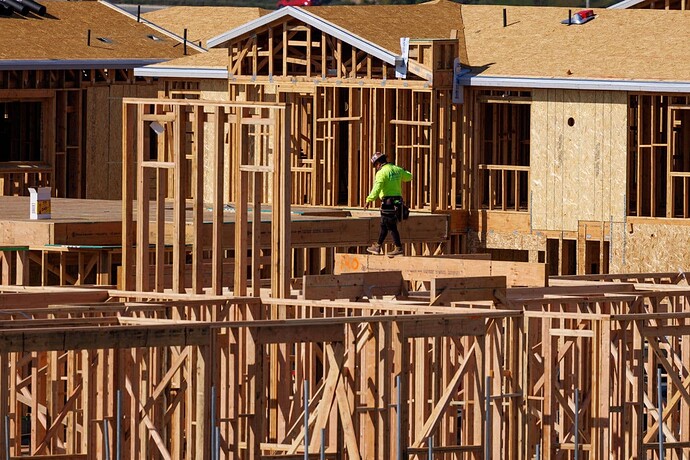Lumber prices have tumbled into building season, a sign that residential construction and home-improvement markets are buckling under high borrowing costs.
The price of two-by-fours, which skyrocketed during the pandemic, is a reliable leading indicator for the housing market. Lately it is flashing caution.
Lumber futures shed 3% Friday to end at $452.50 per thousand board feet, down 27% since mid-March. Wood has piled up in the market and pushed cash prices even lower.
Trade publication and pricing service Random Lengths said its framing-lumber composite price, which tracks on-the-spot sales, fell this past week to $366, the lowest since May 2020. Southern yellow pine, favored for fences and decks, has also dropped to its lowest prices since the depths of the Covid market crash. Random Lengths’ Southern pine composite price declined to $335 this past week.
“The spring rally never happened,” said Russ Taylor, a Vancouver wood-market consultant. “No one is making much money at these prices.”
From labor to logs, sawyers’ expenses have risen a lot since 2020. Many mills are losing money at today’s prices, executives and traders say. Mills afraid of losing skilled workers are in standoffs with competitors to see who will shut down or cut shifts first.
PotlatchDeltic Chief Executive Eric Cremers told investors at a recent conference in New York that the timberland owner’s lumber mills narrowly avoided losses during the first quarter after making $800 million cumulatively over the previous three years.
“To think we’ve got $700 million, $800 million worth of assets breaking even is not fun,” he said.
Just a couple of years ago, sawmills were producing mountains of cash. Wood prices soared after the initial shock of lockdown. Bored-at-home Americans remodeled all at once, and suburban home sales surged. Lumber futures shot to nearly three times the prepandemic record.
Two-by-fours were among the first assets to fall from their pandemic highs when the Federal Reserve began raising interest rates in March 2022. The central bank set out to cool the red-hot housing market and slow the sort of spending that accompanies booming property values.
A strong labor market and shortage of homes for sale kept builders busy. But toward the end of last year, the highest mortgage rates in a generation began to take a toll. North American sawmill capacity fell by 2% in 2023 as closures outweighed openings and expansions, Taylor said.
That wasn’t enough. North America’s largest lumber producer, West Fraser Timber, in January closed mills in British Columbia and Florida and indefinitely curtailed production at another in Arkansas.
The British Columbia closure was the latest in the province, where mills contend with some of the continent’s highest-priced logs. But sawmill closures in the U.S. South are unusual. The last time Southern mills were closing to such an extent was in the aftermath of the 2008 housing crash.
North America’s sawmill operators have flocked to the South over the past decade to feast on the region’s glut of pine timber.
Teal-Jones Group, a closely held Canadian firm with sawmills in the South, filed for bankruptcy protection in late April, blaming high costs and low lumber prices that reduced revenue and the value of its inventory.
Its assets are now for sale. Those include mills in Virginia, Oklahoma, Mississippi, Washington, British Columbia and a majority stake in a Plain Dealing, La., sawmill that is scheduled to open this summer.
Days later, Interfor, another big producer with mills in Canada, the Pacific Northwest and the South, said it would cut its output by 10% this summer. That represented about 0.2% of all North American output and lifted lumber prices, but only temporarily.
Prices resumed their slide as U.S. housing data pointed to sputtering sales and waning demand for wood.
Housing starts declined 17% between February and May, to a seasonally adjusted annual rate of 1.28 million, led lower by dwindling apartment construction.
Meanwhile, building permits for new residential units fell in May to their lowest level since June 2020, when the pandemic boom was just revving up.
“Housing starts came out and confirmed what we were all seeing,” said Stinson Dean, a Colorado lumber broker. “The mills haven’t curtailed enough, apparently.”
Forest-product executives say they expect prices to rebound once more mills close, aligning supply to the meager demand.
They also say that even modestly lower interest rates should help revive the repair and remodeling market, which consumes about 40% of lumber.
High borrowing costs have made it more expensive for Americans to borrow against the higher value of their homes, which is a major source of funding for big repairs and renovations.
“You have a lot of producers that are operating below cash flow break-even,” Weyerhaeuser CEO Devin Stockfish said at the New York investor conference. “People will do that for some period of time, but they won’t do it indefinitely.”
Written by Ryan Dezember
Source: WSJ

